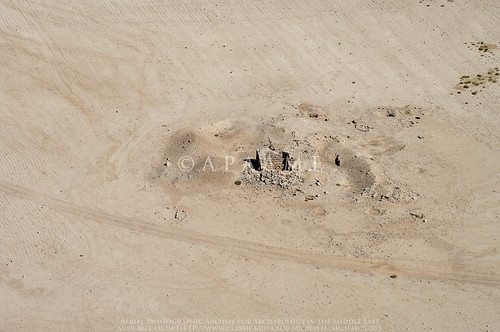Aiming for a 7 o’clock take off we left CBRL at 0630, Andrea and I, with the sun rising and some clouds in the west. As we crossed the Hejaz railway en route to Marka we were overtaken by the Squadron Commander, who waved and we followed him; I was wondering which gate to the air base he’d use (as there is more than one). Every year we have gone through a ritual at the gate where the guards don’t have a clue who we are, despite assurances the previous day that the guards have been informed. Today we followed him through a gate we knew existed but have never used; this is the gate where we have been supposed to enter - the gate where the guards have been forewarned each day (by the squadron commanders) prior to arrival. As it was our last day of the season we will not know if we will have “cracked” the gate until September, when we hope to return.
 |
| The Madaba Martyrs Church, section of Roman Road and the 'Burnt Palace'. Photographer: Robert Bewley. APAAME_20160529_RHB-0017. |
A different crew, our third, and we were airborne by 0705 but the clouds were not looking promising; we did targets around Madaba recording a section of the ancient city about to be sheltered as part of the Archaeological Park and pressed on – with occasional glimpses and one or two superb hilltop sites. However as the land rose there was no distance between it, us and the clouds – so we headed out of the clouds to the east. We had scheduled several sites on the Kerak Plateau and in the Jordan Valley, but these had to be left for September.
 |
| Hill top site of Jabal er-Ras. Photographer: Robert Bewley. APAAME_20160529_RHB-0088. |
Hoping for a quick refuel, we reviewed the potential targets and decided to stay east where visibility was good, but there was a problem with the fuel bowser, so we decided a comfort break was a good idea – even went up the control tower, another first. The delay ended up being short and we managed to do all the scheduled sites in the Al-Hasa and Qatrana area looking at sites reported in the Limes Arabicus Survey.
 |
| Qasr Bshir. The inscription is located above the gate. Photographer: Robert Bewley. APAAME_20160529_RHB-0323 |
We also flew over Qasr Bshir – a first for Andrea and always a pleasure to see, especially when the light is good. I mentioned taking a view of the site in its landscape and the pilot said “you want to land?” and before waiting for answer we were down at tower height, and almost able to read the inscription above the main gate. Great site, though there are serious concerns about the stability of the walls and towers from cracking and masonry tumbles. If ever there is “endangered archaeology” this is it – not from any particular force or agent – just age and lack of maintenance. This is a site of very special importance in terms of its preservation, one of very few in the Roman Empire with such unique upstanding preservation. A tower to the north of the fort, Limes Arabicus Survey site 102, has been completely obliterated by stone robbing and possibly looting.
 |
| The tower (Ariha Tower 23/Limes Arabicus site 102) in 2009. Photographer: Michael Neville. APAAME_20090930_MJN-458. |
 |
| The tower, now obliterated, in 2016. Photographer: Robert Bewley. APAAME_20160529_RHB-0325. |
Our last site of the day was Rujm esh-Shid, a site photographed in Sir Aurel Stein’s 'Limes' Survey and located and flown just last year. Since then, however, the area has been heavily sampled for Uranium (see article: http://www.mdpi.com/2075-163X/5/2/133), and so it was important to photograph the site again to monitor impact. Unfortunately, this site is in an ever-worsening state and without intervention or proper investigation it will surely be lost.
 |
| The site of Rujm esh-Shid in foreground with the pits from Uranium sampling in the background. Photographer: Robert Bewley. APAAME_20160529_RHB-0358. |
After seeing this site we headed back to Amman, unfortunately leaving the remaining scheduled sites in the west for another day with better flying conditions.
Overall, this short season has had three fascinating flights over a ten day period, 13.2 hours and a few thousand photographs, recording new material and a fast changing landscape. It is a privilege to be allowed to undertake such work and in the knowledge and expectation it will, one day, make a difference.
Bob Bewley







No comments:
Post a Comment
Note: only a member of this blog may post a comment.